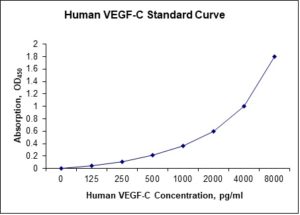Nori Human VEGF-C ELISA Kit
$461.00 – $832.00
This ELISA kit is for quantification of VEGF-C in human. This is a quick ELISA assay that reduces time to 50% compared to the conventional method, and the entire assay only takes 3 hours. This assay employs the quantitative sandwich enzyme immunoassay technique and uses biotin-streptavidin chemistry to improve the performance of the assays. An antibody specific for VEGF-C has been pre-coated onto a microplate. Standards and samples are pipetted into the wells and any VEGF-C present is bound by the immobilized antibody. After washing away any unbound substances, a detection antibody specific for VEGF-C is added to the wells. Following wash to remove any unbound antibody reagent, a detection reagent is added. After intensive wash a substrate solution is added to the wells and color develops in proportion to the amount of VEGF-C bound in the initial step. The color development is stopped, and the intensity of the color is measured.
Alternative names for VEGF-A: Vascular endothelial growth factor (VEGF), vascular permeability factor (VPF), vasculotropin
This product is for Laboratory Research Use Only not for diagnostic and therapeutic purposes or any other purposes.
- Description
- How Elisa Works
- Product Citation (0)
- Reviews (0)
Description
Nori Human VEGF-C ELISA Kit Summary
Alternative names for VEGF-C: Vascular endothelial growth factor C (VEGFC),
| Assay Type | Solid Phase Sandwich ELISA |
| Format | 96-well Microplate or 96-Well Strip Microplate |
| Method of Detection | Colorimetric |
| Number of Targets Detected | 1 |
| Target Antigen Accession Number | P49767 |
| Assay Length | 3 hours |
| Quantitative/Semiquantitative | Quantitative |
| Sample Type | Plasma, Serum, Cell Culture, Urine, Cell/Tissue Lysates, Synovial Fluid, BAL, |
| Recommended Sample Dilution (Plasma/Serum) | No dilution for sample <ULOQ; sufficient dilution for samples >ULOQ |
| Sensitivity | 25 pg/mL |
| Detection Range | 125-8000 pg/mL |
| Specificity | Human VEGF-C |
| Cross-Reactivity | < 0.5% cross-reactivity observed with available related molecules, < 50% cross-species reactivity observed with species tested. |
| Interference | No significant interference observed with available related molecules |
| Storage/Stability | 4 ºC for up to 6 months |
| Usage | For Laboratory Research Use Only. Not for diagnostic or therapeutic use. |
| Additional Notes | The kit allows for use in multiple experiments. |
Standard Curve
Kit Components
1. Pre-coated 96-well Microplate
2. Biotinylated Detection Antibody
3. Streptavidin-HRP Conjugate
4. Lyophilized Standards
5. TMB One-Step Substrate
6. Stop Solution
7. 20 x PBS
8. Assay Buffer
Other Materials Required but not Provided:
1. Microplate Reader capable of measuring absorption at 450 nm
2. Log-log graph paper or computer and software for ELISA data analysis
3. Precision pipettes (1-1000 µl)
4. Multi-channel pipettes (300 µl)
5. Distilled or deionized water
Protocol Outline
1. Prepare all reagents, samples and standards as instructed in the datasheet.
2. Add 100 µl of Standard or samples to each well and incubate 1 h at RT.
3. Add 100 µl of Working Detection Antibody to each well and incubate 1 h at RT.
4. Add 100 µl of Working Streptavidin-HRP to each well and incubate 20 min at RT.
5. Add 100 µl of Substrate to each well and incubate 5-30 min at RT.
6. Add 50 µl of Stop Solution to each well and read at 450 nm immediately.
Background:
Vascular endothelial growth factor C (VEGF-C) is a protein that is a member of the platelet-derived growth factor / vascular endothelial growth factor (PDGF/VEGF) family. It is encoded by the VEGFC gene.[1] The main function of VEGF-C is to promote the growth of lymphatic vessels (lymphangiogenesis) and is a specific growth factor for lymphatic vessels in a variety of models.[2][3]. It acts on lymphatic endothelial cells (LECs) primarily via its receptor VEGFR-3 promoting survival, growth and migration. it can also promote the growth of blood vessels and regulate their permeability. The effect on blood vessels can be mediated via its primary receptor VEGFR-3[4] or its secondary receptor VEGFR-2. Apart from vascular targets, VEGF-C is also important for neural development[5] and blood pressure regulation.[6] In a minority of lymphedema patients, the condition is caused by mutations in the VEGFC gene.[7] While lack of VEGF-C results in lymphedema, VEGF-C production is implicated in tumor lymphangiogenesis and metastasis. Expression of VEGF-C by tumors induces peri-tumoral and intratumoral lymphangiogenesis what potently promotes metastatic dissemination of tumor cells.[8] VEGF-C primarily stimulates lymphangiogenesis by activating VEGFR-3, yet under certain conditions it can also act directly on blood vessels to promote tumor angiogenesis.[4]
References
- Paavonen K, et al. (1996). Circulation. 93(6): 1079–1082.
- Oh SJ, et al. (1997). Developmental Biology. 188(1): 96–109. .
- Jeltsch M, et al. (1997). Science. 276(5317): 1423–1425.
- Tammela T, et al. (2008). Nature. 454(7204): 656–660.
- Le Bras B, et al. (2006). Nature Neuroscience. 9(3): 340–348.
- Machnik A, et al. (2009). Nature Medicine. 15(5): 545–552.
- Balboa-Beltran E, et al. (2014). Journal of Medical Genetics. 51(7): 475–478.
- Skobe M, et al. (2001). Nature Medicine. 7(2): 192–198.
Be the first to review “Nori Human VEGF-C ELISA Kit”
You must be logged in to post a review.




























Reviews
There are no reviews yet.